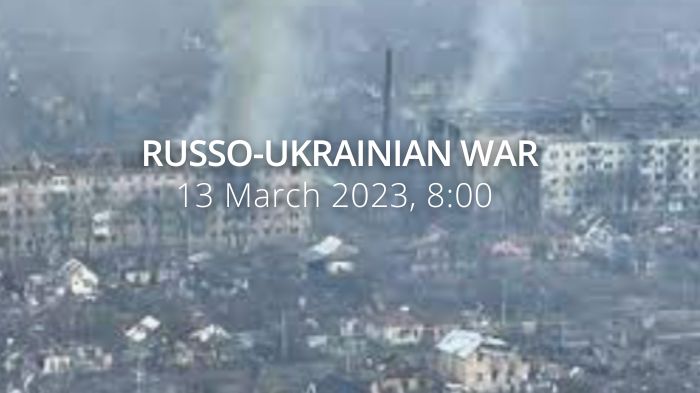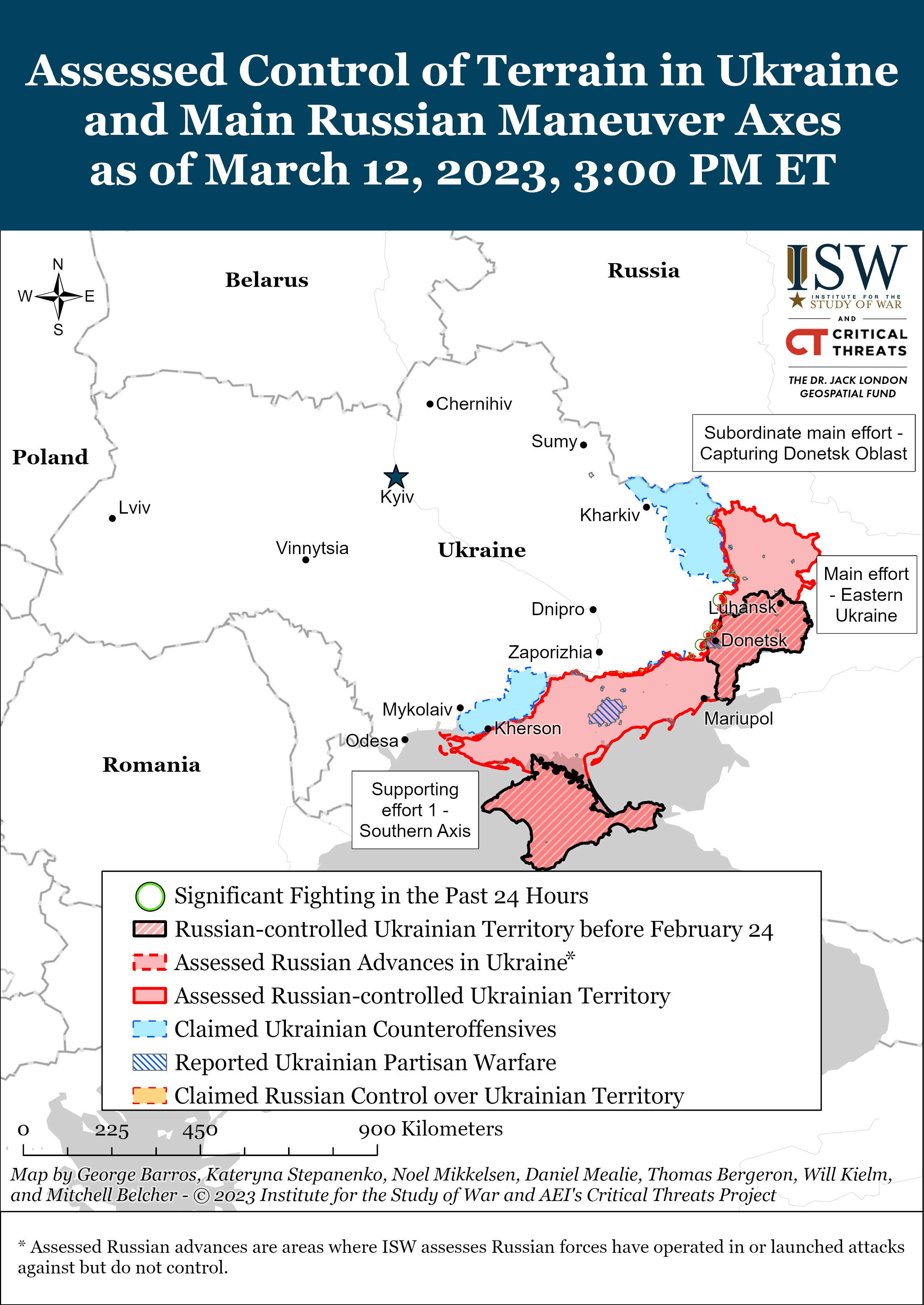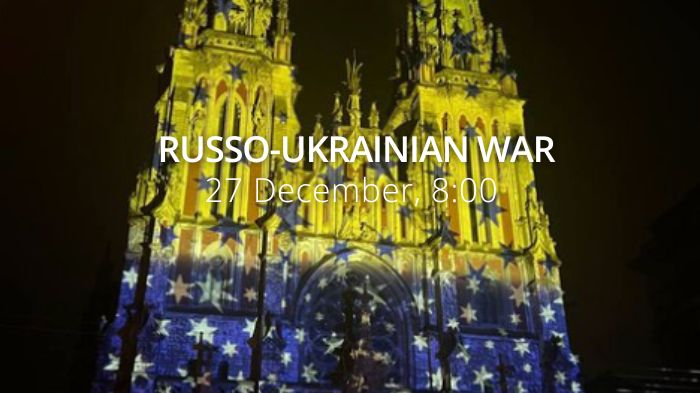Russia stocked approximately 50 Kinzhal hypersonic missiles to target Ukraine. Russia intensified terror against children and their parents in occupied parts of Kherson and Zaporizhzhia Oblasts. No major changes near Bakhmut.
President Zelenskyy awarded the title Hero of Ukraine to Oleksandr Matsiyevskyi who was a Ukrainian soldier gunned down by Russians after saying 'Glory to Ukraine'
https://t.co/2M3EefSHpG— Euromaidan Press (@EuromaidanPress) March 12, 2023
Daily overview — Summary report, March 13
A map of the approximate situation on the ground in Ukraine as of 00:00 UTC 05/03/23.
There have been no notable changes to control since the last update. pic.twitter.com/zUjmipIpuw
— War Mapper (@War_Mapper) March 5, 2023
The General Staff’s operational update regarding the Russian invasion as of 18.00 pm, March 13, 2023 is in the dropdown menu below:
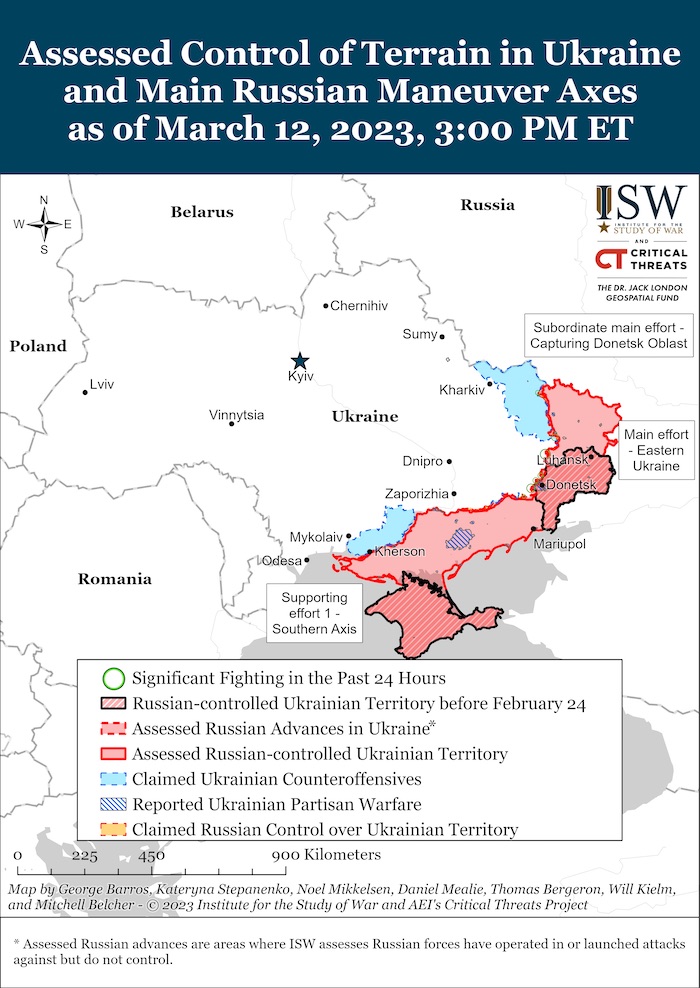
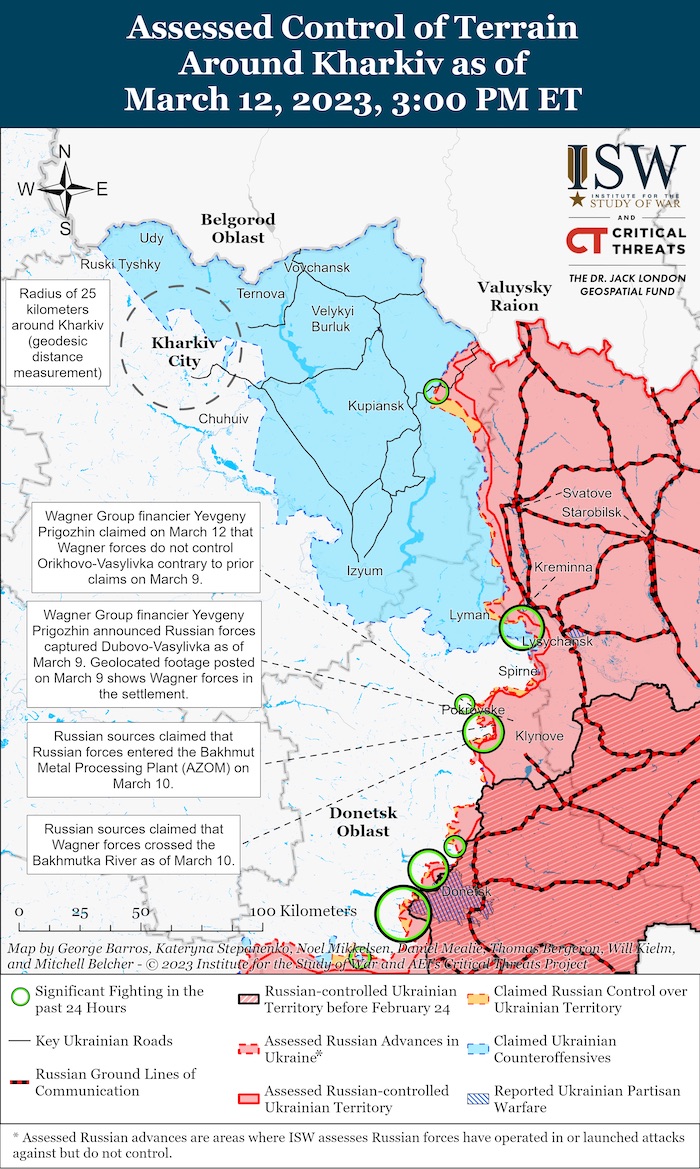
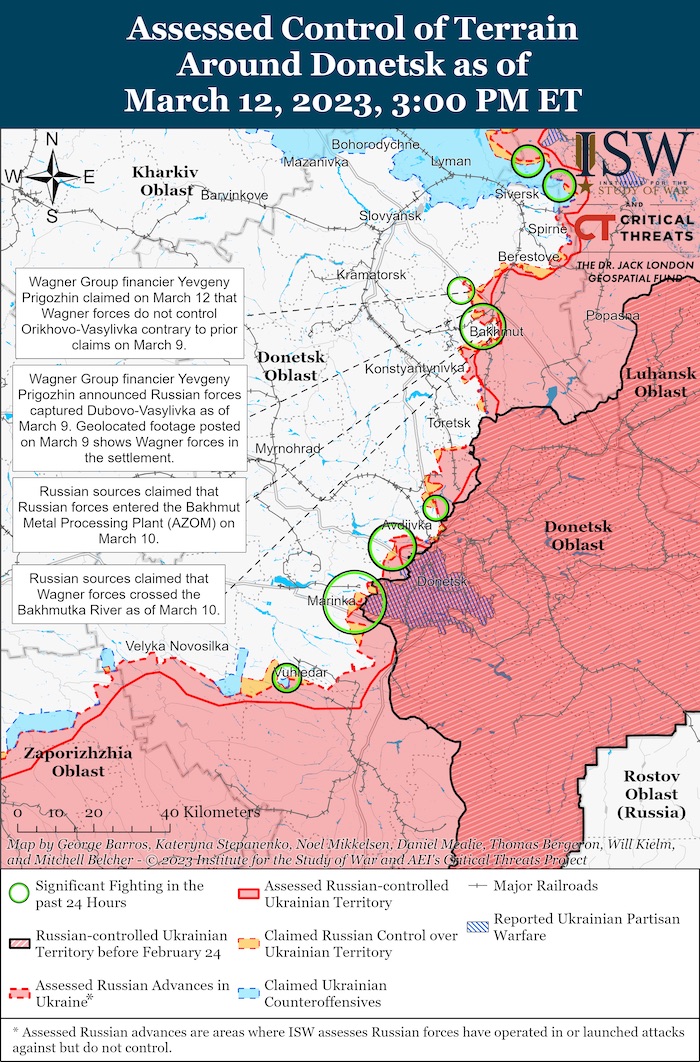
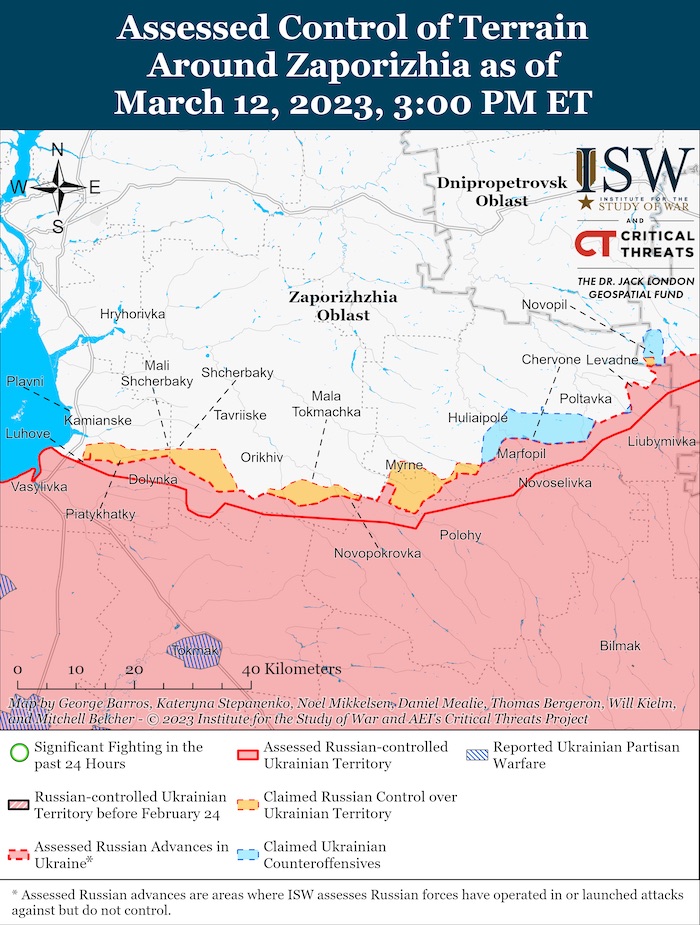
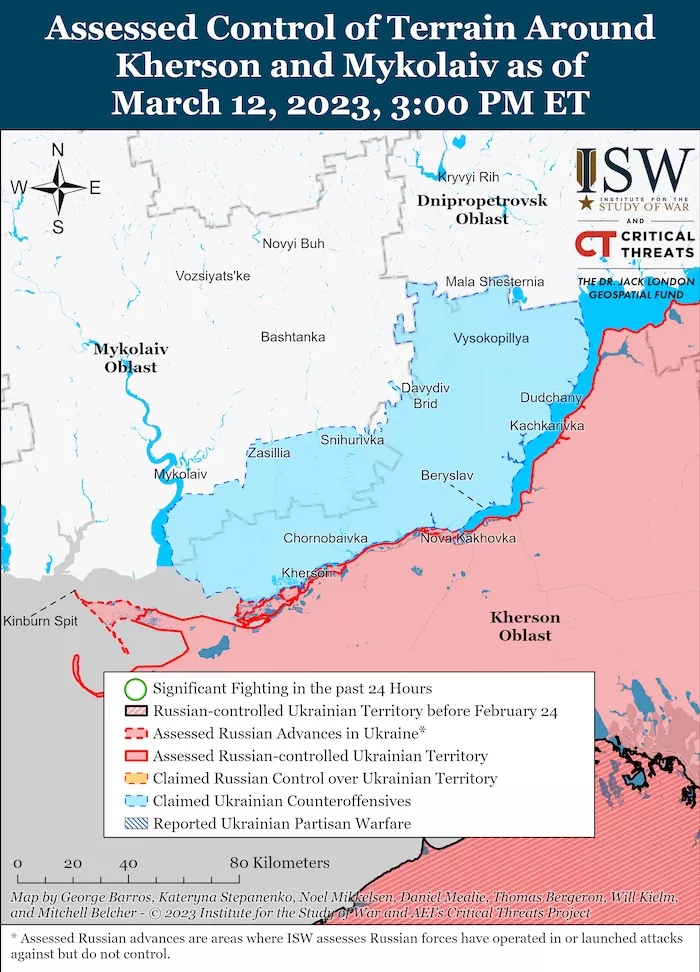
Military Updates
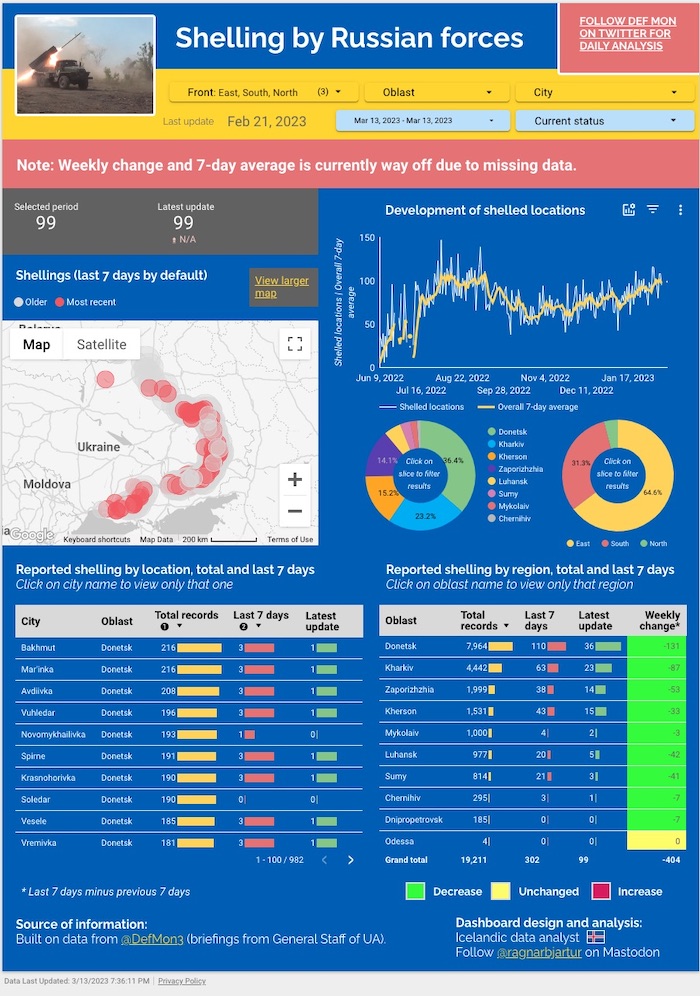
Russia stocked near 50 Kinzhal hypersonic missiles to target Ukraine – Air Force, The Russian Army had 50 Kinzhal hypersonic missiles designed to hit “decision-making centers” before the latest massive attack on Ukraine, Yuriy Ihnat, a spokesman for Ukraine’s Air Force, said during an interview with Freedom channel. On 9 March, invaders launched six Kh-47 Kinzhals at Ukraine, which according to the Russian military, are capable of accelerating to a speed of 5,000 km/h in a few dozens of seconds. However, they could only hit power transformers. Russians tried to locate SAM Patriot during recent missile attack – Operational Command South. During the March 9 massive missile attack on Ukraine, the Russians were looking for Patriot SAM systems. This is according to Nataliia Humeniuk, the spokeswoman for the security and defense forces of Ukraine’s Operational Command South, UNIAN reports. According to her, the Ukrainian Defense Forces knew the attack would be undulating, and expected the enemy to build up forces for it. First, the invaders launched kamikaze drones across Ukraine, then missiles. Such tactics were used to check whether Ukraine already has new air defense systems in service.
As Ukrainian troops monitor the situation, Russian forces may set up more firing points on the Kinburn Spit facing the town of Ochakiv across the Dnipro estuary – OpCommand South spox Humeniukhttps://t.co/9V6HhECIwN
— Euromaidan Press (@EuromaidanPress) March 12, 2023
Russia may set up more firing points on Kinburn Spit in Dnipro estuary – Operational Command South. As Ukrainian troops monitor the situation, Russian forces may set up more firing points on the Kinburn Spit facing the town of Ochakiv across the Dnipro estuary. Nataliia Humeniuk, the spokeswoman for the security and defense forces of Ukraine’s Operational Command South, said this on national television, Ukrinform reports.
During the Mar 9 massive missile attack on Ukraine, the Russians were trying to detect and locate Patriot SAM systems – OpCommand South spox Nataliia Humeniukhttps://t.co/LrHENgGo6I
— Euromaidan Press (@EuromaidanPress) March 12, 2023
According to British Defence Intelligence, (last 48 hours):
https://twitter.com/DefenceHQ/status/1635215376278769665
- In recent weeks, Wagner Group owner Yevgeny Prigozhin has likely lost access to recruiting in Russian prisons due to his ongoing disputes with the Russian MoD leadership. Prigozhin is highly likely pivoting recruitment efforts towards free Russian citizens.
- Since the start of March 2023, Wagner has set up outreach teams based in sports centres in at least 40 locations across Russia. In recent days, masked Wagner recruiters also gave career talks in Moscow high schools, distributing questionnaires entitled ‘application of a young warrior’ to collect the contact details of interested pupils.
- About half of the prisoners Wagner has already deployed in Ukraine have likely become casualties and the new initiatives are unlikely to make up for the loss of the convict recruit pipeline. If the ban endures, Prigozhin will likely be forced to reduce the scale or intensity of Wagner operations in Ukraine.
Losses of the Russian army
Russia’s estimated losses in Ukraine on day 383 of the all-out war, according to Ukraine’s GenStaff.
- 710 troops
- 8 tanks
- 5 armored vehicles
- 16 artillery pieces
- 6 transport vehicles
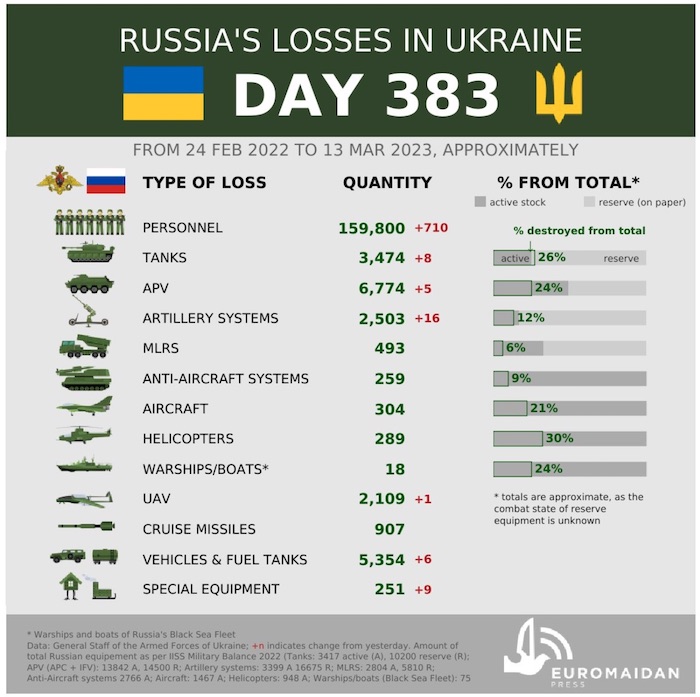
Humanitarian
https://twitter.com/EuromaidanPress/status/1635171491028561921
Three civilians killed in Russian shelling of Kherson Oblast. On 11 March, Russian troops shelled Kherson Oblast 29 times with heavy artillery and Grad multiple launch rocket system, Head of Regional Military Administration Oleksandr Prokudin said. According to him, ten projectiles hit residential buildings and private houses, killing three civilians and injuring another three.
"An attack on Kostiantynivka a day earlier injured 8 people and destroyed or damaged more than a dozen houses. The barrages have overwhelmed local firefighters, who take great risks putting out fires in buildings and cars even as the shelling continues."https://t.co/xCM6ZTtF1O pic.twitter.com/3QFfStgzfY
— Euromaidan Press (@EuromaidanPress) March 13, 2023
Legal
‘Court’ in occupied Crimea fines woman for ‘discrediting Russian army’ by video with Ukraine’s national anthem. A 20-year-old woman from Russian-occupied Crimea has been fined 50 thousand roubles for posting a video with Ukraine’s national anthem on social media. This is the latest, but surely the most surreal, of many prosecutions in occupied Crimea over songs since Russia began its full-scale invasion of Ukraine. The occupation ‘Bakhchysarai district court’ reported on 10 March that a resident of the district had faced administrative liability for supposedly ‘discrediting the Russian Federation’s armed forces’.
Russia intensifies terror against children and their parents in occupied parts of Kherson and Zaporizhzhia oblasts. For Russia’s ideological warfare, the younger its victims, the better. Moscow is intent on inculcating ‘Russian world’ ideology in occupied parts of the Kherson and Zaporizhzhia oblasts, and it needs children to receive maximum exposure to such propaganda at school. It is no longer only adults who face being stopped and searched, with children regularly having their mobiles scrutinized for ‘seditiously’ pro-Ukrainian text conversations with their parents. In another déjà vu from Soviet times, attempts are made to get children to tell on fellow classmates who are studying at home according to the Ukrainian curriculum.
Support
Poland and UK plan to build a massive arms factory to help produce and repair equipment and weapons destined for Ukraine – The Telegraph https://t.co/k381ZwSTc4
— Euromaidan Press (@EuromaidanPress) March 12, 2023
Luxembourg sends 14 armored ambulances to Ukraine. On 18 March, the Embassy of Ukraine in the Kingdom of Belgium said Luxembourg sent another batch of humanitarian aid to Ukraine, namely 14 armored ambulances produced by the British company “Venari”. “Very soon the vehicles will be sent to the front line, where they will fulfill their primary mission – to save the lives of our warriors who defend our country, as well as civilians who are constantly become victims of barbaric Russian shelling,” the embassy added.
US and Ukraine top military chiefs discuss supply of ammunition and military gear. On 11 March 2023, the Commander-in-Chief of Ukraine’s Armed Forces General Valerii Zaluzhnyi talked over the phone with the US Chairman of Chiefs of Staff General Mark Milley. The top military chiefs discussed the supply of ammunition and military gear that Ukraine needs to repel the Russian invasion, General Zaluzhnyi informed. Apart from that Zaluzhnyi stressed the importance of strengthening Ukraine’s air defense capabilities in the face of Russian missile and drone attacks. It is the second conversation between generals Zaluzhnyi and Milley this week. The last one was on Wednesday, 8 March.
New Developments
https://twitter.com/EuromaidanPress/status/1635205302588162054
Finland can’t afford sending Hornet jets to Ukraine before replacement F-35As arrive – Finnish Air Force Commander. During her visit to Ukraine on March 10, Finnish Prime Minister Sanna Marin said that Finland should discuss supplying Hornet fighter jets to Ukraine: “Yes, I think we can also have a discussion regarding the Hornets, whether it would be possible to hand them over to Ukraine and what kind of training it would need,” she said in Kyiv.
Moldovan police said on Mar 12 they have foiled a plot by groups of Russia-backed actors who were specially trained to cause mass unrest during a protest the same day in the capital against the country’s new pro-Western government.https://t.co/kDsqRBfQwN
— Euromaidan Press (@EuromaidanPress) March 12, 2023
Tanker that headed to Russia may be related to explosions at Nord Stream pipelines – Insider. The Minerva Julie, a Greek-flagged tanker that headed from the Netherlands to Russia, may be connected to the destruction of the Nord Stream Pipelines in the autumn of 2022, according to the Danish OSINT analyst Oliver Alexander, Insider reported. Oliver Alexander spent many months analyzing data from the maritime Automatic Identification System (AIS), from vessels that passed near the site of three out of the four pipeline ruptures shortly before the explosions took place. He noticed that the Minerva Julie was heading east from Rotterdam.
How a facility in Canada's central Alberta is using Ukrainian seeds to unlock hemp's true potentialhttps://t.co/dMvTsdSrHM
— Euromaidan Press (@EuromaidanPress) March 13, 2023
Assessment
- On the war.
The Institute for the Study of War has made the following assessment as of March 12, 2022:
ISW is publishing an abbreviated campaign update today, March 12. This report establishes a comprehensive timeline of the rivalry between Wagner Group financier Yevgeny Prigozhin and the Russian Ministry of Defense (MoD), which likely reached a boiling point over Bakhmut. The report also analyzes the Russian MoD’s likely intent to expend Wagner forces in Bakhmut and explores Russian President Vladimir Putin’s manipulation of this conflict to maintain the stability of his regime.
The conflict between the Russian Ministry of Defense (MoD) and Wagner Group financier Yevgeny Prigozhin likely reached its climax against the backdrop of the Battle of Bakhmut. The Russian MoD – specifically Russian Defense Minister Sergey Shoigu and Chief of the Russian General Staff General Valery Gerasimov – is likely seizing the opportunity to deliberately expend both elite and convict Wagner forces in Bakhmut in an effort to weaken Prigozhin and derail his ambitions for greater influence in the Kremlin. The Russian MoD had been increasingly restricting Prigozhin’s ability to recruit convicts and secure ammunition, forcing Prigozhin to publicly recognize his dependency on the Russian MoD. Prigozhin, for example, publicly complained that he mailed a letter and tried to send his representative – likely to Shoigu and Gerasimov – with an urgent demand for ammunition, but that the representative was not allowed to present his complaints.[1] Prigozhin had been able to grow his forces by 40,000 convicts likely with the Kremlin’s permission to recruit in prisons in 2022 but lost that permission and access to that manpower pool at the beginning of 2023.[2] Prigozhin has threatened to withdraw Wagner forces from Bakhmut and insinuated that the Russian MoD used Wagner to bear the brunt of the high-intensity attritional urban warfare to seize Bakhmut in order to conserve Russian conventional forces.[3] These threats and complaints indicate that Prigozhin is aware of the gravity of his conflict with the Russian MoD.
The Russian military leadership may be trying to expend Wagner forces – and Prigozhin’s influence – in Bakhmut. Russian forces’ rate of advance in Bakhmut slowed following the Ukrainian withdrawal from eastern Bakhmut around March 7.[4] ISW assessed on March 6 that Wagner had to commit its elite forces to maintain offensive momentum in Bakhmut but may be running out of these forces during direct assaults on eastern, southern, and northern parts of Bakhmut.[5] Geolocated footage published on February 18 showed 43 buses with Wagner mercenaries moving from Crimea via Melitopol possibly to reinforce positions in Bakhmut.[6] Prigozhin complained on March 5 and 6 that Wagner needed additional reinforcements, and Ukrainian military officials observed that Russian forces were suffering a seven-to-one casualty ratio compared to Ukrainian forces.[7]
Prigozhin likely anticipated that Ukrainian forces would entirely withdraw from Bakhmut out of fear of imminent encirclement and hoped that his commitment of Wagner’s elite forces would be sufficient to generate that effect. Prigozhin even offered Ukrainian President Volodymyr Zelensky to allow Ukrainian forces to withdraw from Bakhmut in two days on March 3.[8] Limited information about the Prigozhin’s pleas likely indicates that the Russian military command is intent on expending Wagner forces within the city. Spokesperson of the Ukrainian Eastern Group of Forces Serhiy Cherevaty also noted on March 11 that Ukrainian forces may be able to severely degrade Wagner and have already thinned out Wagner’s second prisoner formation over the winter.[9] Ukrainian servicemen noted in a social media video from March 12 that they are holding positions in Bakhmut waiting for Russians to “shoot each other.”[10] Russian military leadership may be allowing the Wagner Group to take high casualties in Bakhmut to simultaneously erode Prigozhin’s leverage while capturing the city at the expense of Wagner troops.
The Russian military leadership is likely attempting to avenge itself on Prigozhin for a conflict that he initiated in May 2022. ISW assessed on January 22 and February 26 that the Kremlin likely lent Prigozhin its support when Russian President Vladimir Putin sought to replenish his forces with volunteer recruits to avoid declaring highly unpopular mobilization.[11] Prigozhin likely convinced Putin that he would be able to seize Bakhmut if given access to the Russian MoD’s ammunition stocks and allowed to expand his existing ultranationalist recruitment campaigns to include regular Russians and prisoners.[12] Putin granted Prigozhin access to those resources as he had likely become increasingly disillusioned with the Russian military command that had failed to capture Kyiv and effectively wasted reserves without achieving a tangible result. Putin likely perceived the Russian military command’s appeals for mobilization as a threat to the stability of his regime and placed his confidence in Prigozhin whose forces had already helped seize Popasna, Sievierodonetsk, and Lysychansk in Luhansk Oblast.[13] Putin’s decision to side with Prigozhin likely angered Shoigu and Gerasimov, who were then tasked with sharing limited equipment and ammunition with Wagner mercenaries.
Prigozhin has also waged a relentless defamation campaign against the Russian MoD and the military command since May 2022 – first covertly via Wagner-affiliated ultranationalist social media platforms. Wagner-affiliated milbloggers began to boast about Wagner’s successes in assault operations and even spread the idea that Prigozhin could replace Shoigu as defense minister in September 2022.[14] These milbloggers capitalized on the increasing criticism among the Russian ultranationalist communities aimed at the Russian conventional military command that failed to maintain the initiative following the exhausting capture of Lysychansk and Sievierodonetsk. Wagner was able to exploit the greater ultranationalist community because the ultranationalists shared the objective of improving the war effort and saw a common enemy in the Russian MoD and its bureaucracy. The ultranationalist community had also been extremely interconnected over the years prior to the full-scale Russian invasion of Ukraine and drew on the same recruitment pools.
Prigozhin overestimated Putin’s reliance on Wagner forces and attempted to replace Russian military and political leadership with Wagner-affiliated figures. Prigozhin exploited the Russian military’s failures during Ukraine’s sweeping counteroffensives in Kharkiv Oblast and Lyman in Donetsk Oblast, and the turbulent reserve mobilization in September-October 2022 to establish Wagner-affiliated personnel in place of disgraced military commanders. Prigozhin made a publicized entrance into the Russian information space in a prisoner recruitment video on September 14, only three days after the Russian loss of much of Kharkiv Oblast.[15] Prigozhin later rode the wave of domestic criticism of the Russian MoD’s inability to properly conduct a reserve call-up on September 21 and used the opportunity to promote recruitment into the Wagner Private Military Company (PMC).[16]
Prigozhin, alongside Chechen leader Ramzan Kadyrov, used the fall of Lyman to push for and ultimately secure the firing of Commander of the Central Military District (CMD) Alexander Lapin who had reportedly commanded the Lyman grouping of forces.[17] Prigozhin and Kadyrov both served alongside Lapin during the battles of Sievierodonetsk and Lysychansk, and Lapin received credit for seizing Lysychansk with Wagner-affiliated Army General Sergey Surovikin on July 3, 2022.[18] US intelligence officials reported that persistent military failures – likely the loss of Kharkiv Oblast and Lyman, faulty mobilization, and the annexation of four partially-occupied Ukrainian regions on September 30 – had ignited a wave of criticism within Putin’s inner circle.[19] US intelligence later revealed that Prigozhin directly addressed Putin regarding these military failures, likely leading to the appointment of Surovikin as the commander of the Russian group of forces in Ukraine.[20] Ukrainian intelligence linked Surovikin with Wagner, and Prigozhin even offered praise to Surovikin in response to his appointment.[21] Reports of Lapin’s dismissal as the commander of the “central” grouping of forces appeared on November 1, shortly following Surovikin’s appointment.[22]
Prigozhin sought to establish Wagner-affiliated military officials partly to secure greater access to Russian MoD ammunition stores and budget. Prigozhin’s ability to sustain and grow Wagner forces tenuously relied on his ability to retain favor with Putin who would order the Russian MoD and other federal institutions to support these mercenaries. The Ukrainian Resistance Center reported that Prigozhin and Kadyrov sought to undermine Shoigu in order to receive access to the Russian MoD budget to pursue other political goals through the growth of their paramilitary organizations.[23] ISW also observed that Prigozhin had extensively targeted St. Petersburg Governor Alexander Beglov and claimed to have contracted his own advisors to the local administration, likely in hopes of gaining political and commercial power in the city.[24] Prigozhin admitted on February 20 that Surovikin had been assisting Wagner in obtaining ammunition, further confirming that Wagner forces benefited from specific connections within the Russian military leadership that Prigozhin had likely helped rise in power.[25]
Prigozhin’s obvious military-political ambitions likely alarmed Putin in October, when his regime was most vulnerable to public scrutiny. Putin likely warned Prigozhin obliquely on October 5, 2022, in an odd allusion to the Pugachev Rebellion that challenged Catherine the Great’s authority in the mid-1770s, for example.[26] Putin noted that the rebellion occurred because Pugachev “claimed to a be tsar” and because of the “weakening of the central power.” Putin’s bizarre public statement, apropos of nothing, may have been a direct response to Prigozhin’s criticism of the war effort and attempts to enhance his own military and political influence. Kremlin officials also confirmed that Putin has been increasingly preferring loyalty over competence within his inner circle, and Putin may have perceived Prigozhin’s critiques a form of disloyalty.[27] Prigozhin likely did not intend to challenge Putin directly, but Putin likely saw Prigozhin’s aggressive self-promotion at the expense of others who had Putin’s trust as a threat. Shoigu and Gerasimov, after all, have been loyal to Putin and his regime structure for years and likely erred by excessive loyalty – failing to tell Putin what Putin did not want to hear – a trait Putin seems willing to forgive.
Putin is a risk-averse and highly calculating actor who likely sought to manage the emerging threat to his control by gradually reintroducing the Russian MoD into prominence and power. The Russian MoD reportedly started recruiting prisoners in October, which likely cut into Prigozhin’s recruitment efforts.[28] Shoigu was allowed to make high-profile contacts with French, Turkish, UK, and US counterparts on October 23 – establishing a level of authority unattainable for Prigozhin, who holds no official position in the Russian government.[29] Gerasimov made similar calls to his UK and US counterparts on October 24 after having been absent from the public eye since the spring of 2022.[30] Putin continued to appease Prigozhin and his ultranationalist community during this period because he likely recognized that the involuntary reserve call-up could not close the gap between Russian force requirements and available manpower in a timely fashion and thus let Wagner expand its recruitment of prisoners and its operations on the frontline until the mobilized personnel could arrive en masse.[31] Putin likely stopped the Russian MoD from directly attacking Prigozhin but instead created conditions in which the Russian military leadership could reassume more authority. Such conditions likely threatened Prigozhin, who began to intensify his criticism of the Russian MoD and further deepened the conflict between Wagner forces and military leadership.
Putin had ultimately allowed the Russian MoD to retake control of the Bakhmut direction from Prigozhin in January as Wagner forces failed to deliver the promised victory over Bakhmut by the end of 2022. Putin appeared in several meetings with Gerasimov and Shoigu in late December 2022, likely indicating that he was not confident that Prigozhin would achieve the promised victory before the end of the year.[32] The Russian military leadership may have also been successful in convincing Putin that Wagner forces were not a good investment of resources as Russia began to run low on shells around the same timeframe.[33] Putin ostentatiously demoted Surovikin and appointed Gerasimov as the theater commander in Ukraine on January 11.[34] Putin similarly appointed Lapin as the Chief of the Russian Ground Forces on January 10 and reshuffled the Russian military command in Ukraine.[35] The Russian MoD claimed responsibility on January 13 for the capture of Soledar and deliberately failed to acknowledge Wagner in the success.[36] Putin himself failed to credit Prigozhin for the capture of Soledar in an unusual TV interview on January 15 and instead attributed the victory to the Russian MoD and General Staff.[37] Kremlin Spokesperson Dmitry Peskov also indirectly accused Prigozhin of deliberately manipulating the information space to expose the conflict between Wagner and the Russian MoD.[38] Putin also met with Prigozhin’s long-standing nemesis Beglov on January 18, likely in a deliberate attempt to further marginalize Prigozhin.[39] The Kremlin had cut off Prigozhin’s access to prisoner recruitment since the start of 2023.[40]
Putin and the Russian MoD may use Prigozhin as a scapegoat for the costly drive on Bakhmut once the offensive culminates. ISW assessed on February 5 that Putin relies on a group of scapegoats to publicly take risks in his place and shoulder the blame for Russian military failures and unpopular policies.[41] Putin will likely use Wagner’s high casualties, reports about poor morale, and war crimes to deflect from likely equal or possibly worse problems within the Russian Armed Forces. Kremlin-affiliated milbloggers have ambushed Prigozhin with interviews that exposed numerous Wagner controversies regarding the ineffectiveness and mistreatment of the Wagner convict force – likely in an effort to set conditions in the Russian information space to discredit Wagner.[42] Much of the Russian and Western coverage of Bakhmut already focuses mainly on heavy Wagner losses, allowing the MoD to cover up or downplay other losses suffered by Russian conventional forces. The revelation of high losses among Wagner convicts and mercenaries would not cause as much societal outrage as ongoing reports of casualties and mistreatment of involuntarily mobilized servicemen.
Prigozhin is unlikely to regain Putin’s favor to the same extent as he had between May and October 2022. Unnamed Kremlin officials stated that Putin has been increasingly tightening his inner circle and is unlikely to offer the benefits Prigozhin once had regardless of the severity of the Russian military failures on the frontlines.[43] The Russian MoD still apparently retains favor with Putin despite devastating military failures around Vuhledar in early February.[44] The Kremlin is creating new armed formations under state energy companies likely in an effort to replace Wagner while possibly retaining a counterbalance to the Russian MoD.[45] Prigozhin’s fall from grace will likely scare other Kremlin officials such as Kadyrov into scaling down their ambitions to avoid experiencing Prigozhin’s fate.[46] Putin has likely not decided yet whether he will spare Prigozhin, and Wagner’s fate likely depends on Prigozhin’s ability to convince the Kremlin of his loyalty.
Prigozhin is also unlikely to reach his previous heights regardless of his renewed efforts to recruit mercenaries from 42 different cities in Russia.[47] Prigozhin had earned a bad reputation for the treatment of his forces as cannon fodder and had drained ultranationalist communities of recruits.[48] Prigozhin’s public pleas for ammunition and supplies are also unlikely to make service with Wagner attractive to recruits. Prigozhin has fractured and polarized the previously interconnected ultranationalist community which had aided him in the recruitment of forces earlier in the war and in prior conflicts worldwide.[49]
The conflict between the Russian MoD and Wagner shows that different parties in Putin’s inner circle are competing with one another in potentially zero-sum games that do not further Putin’s overall objectives. The Russian MoD is currently prioritizing eliminating Wagner on the battlefields in Bakhmut, which is likely slowing down the rate of advance in the area. Prigozhin saw Bakhmut as an opportunity to gain leverage on the Russian MoD and likely in the Kremlin in pursuit of his own commercial and political aspirations. Putin used Wagner to protect his regime from detrimental societal ramifications of mobilization, which also continues to inhibit his war efforts in Ukraine.
Key inflections in ongoing military operations on March 12:
- Russian Foreign Ministry Spokesperson Maria Zakharova claimed on March 12 that ISW’s March 11 report about her comments acknowledging Kremlin infighting is false and an “informational attack.”[50] ISW used accounts from Russian media sources as well as a Russian milblogger (who claimed to be in attendance) to report on Zakharova’s comments in an altercation with information space entrepreneur Igor Ashmanov during a panel discussion in Moscow.[51] A milblogger who attended the event quoted Zakharova as saying that Kremlin cannot replicate the Stalinist approach of establishing a modern equivalent to the Soviet Information Bureau to centrally control Russia’s internal information space due to infighting among unspecified Kremlin “elites.”[52] The milblogger did not comment on Zakharova’s denial on March 12 but amplified a social media post from another milblogger who claimed that the West (presumably ISW) misrepresented Zakharova’s statements.[53] The social media post, however, also blamed Zakharova and the Kremlin for failing to adopt stronger information space policies. Several other milbloggers confirmed that Ashmanov accused Kremlin organs of failing to create a trusted centralized information campaign but argued about how other attendees attempted to downplay his statements.[54] This milblogger discourse not only confirms that the incident occurred, but also that ultranationalist figures reiterated variants of ISW’s assessment that the Kremlin’s ability to control the Russian information space is diminishing.
- Iranian State Media announced on March 11 that Iran has finalized a deal to buy Sukhoi-35 fighter jets from Russia.[55]
- Russian forces conducted limited ground attacks along the Kupiansk-Svatove-Kreminna line.[56]
- Russian forces continued offensive operations near Bakhmut but have not completed a turning movement, envelopment, or encirclement around the city.[57] Russian milbloggers claimed that Wagner Group fighters captured parts or all of Orikhovo-Vasylivka (11km northwest of Bakhmut), although Wagner Group financier Yevgeny Prigozhin stated that Wagner fighters do not control the settlement.[58]
- Russian forces conducted ground attacks near Avdiivka and along the western outskirts of Donetsk City.[59] Russian milbloggers claimed that Russian forces entered Krasnohorivka (9km north of Avdiivka), although ISW has not observed visual confirmation of these claims.[60]
- A Russian milblogger claimed on March 12 that there is a high desertion rate among SPETSNAZ forces.[61] The Russian milblogger claimed that no SPETSNAZ units are at their full complement and that some SPETSNAZ commanders have fled their units despite having received generous salaries for the past ten years.[62] ISW has no independent confirmation of these assertions. It appears unlikely that most commanders have fled these elite units.
- The United Kingdom Ministry of Defense (UK MoD) reported on March 12 that Russian military personnel from eastern regions of Russia die in Ukraine at per capita rates up to fortyfold of those of Russian personnel from Moscow City.[63] The UK MoD reported that Kazakh and Tatar minorities make up 75 percent of casualties among Russian military personnel from Astrakhan Oblast.[64]
- Deputy Ukrainian Prime Minister Iryna Vereshchuk stated on March 12 that Russian officials have illegally deported 2,161 Ukrainian orphans to Russia.[65] Vereshchuk also stated that the total number of children deported to Russia may be approximately 150,000.[66]




